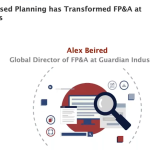“If the rate of change on the outside exceeds the rate of change on the inside...
Introduction
Driver-based planning is a key topic for any FP&A team today. But what is not always clear is just how driver-based planning is connected to requirements from stakeholders.
This article aims to provide some food for thought on this topic, using examples derived from a €1 billion revenue company which manages 160,000 assets in the leasing, maintenance and repair of trucks & trailers. The company operates in 18 countries throughout Europe and Canada and has tripled in size in the last 7 years.
Get the basics right
Before looking at stakeholder management, it is important to have the basic structure right.
Enhanced driver-based planning within the company is part of a roadmap towards world-class FP&A. This roadmap involves optimising the tools and skill set of the FP&A team, while improving understanding of the different operational processes feeding into the planning processes.
A strong emphasis is placed on standardisation and enhanced data management as input for the planning. As the company has a strong acquisition agenda, this is challenging.
Let’s also not forget that change management and transition of operational planning are elements which have a big impact on the success of implementing effective driver-based planning.
Enhanced IT capabilities are a necessity
After understanding and aligning the basics, a strong IT tool set is required.
Digital interventions that occur throughout the planning process are aligned to a target operating FP&A model.
The company has implemented a data warehouse with a reporting tool overlayed, both from a leading software supplier. In 2021 the company implemented a cloud-based planning tool, which was selected from a range of 10 options qualified by Gartner as leading tools in the market.
The planning tool, the reporting tool and the data warehouse are part of an overall enhancement of the company-wide ERP environment.
Stakeholder management in an uncertain environment
After having the basics right and tools in place, it is important to understand which requirements from stakeholders should be considered when setting up driver-based planning.
During the last ten years, the company has changed ownership three times, from a global American multinational, via a Chinese conglomerate expanding abroad, to currently being Private Equity-owned. There is a strong emphasis on constant dividend streams, improved Return on Equity evolvement, and eventually an exit scenario.
Debt funding, for a leasing company, is playing an important role. This means that key drivers include impacts on covenants, such as solvency and interest coverage ratio, and diversification of funding.
Internally the planning process is also used for target setting and driving profitable growth via €400m to €500m annual investments in assets (fleet and PP&E).
Driver-based planning at asset category level is therefore seen as a key element in connecting the strategic plan to the planning process. This is part of a full range of finance processes, as can be seen below.

Source: TIP Trailer Services, March 2022
Link strategic planning to operational planning via drivers
As part of the overall enhancement of the ERP environment, the company has undertaken a complete review of the Finance Data Model dimensions.
Although this exercise is ongoing, it has already helped in providing clarity on ownership of data inputs and consolidation for several dimensions, as these are replicated in the planning process. This has happened with products such as leasing, rental, maintenance & repair, and also around different asset categories such as trailers, trucks and workshops.
Due to the matrix structure of the company, ownership is across a range of headquarter teams and regional/functional teams. It is important to understand the structure when looking at the drivers used.
It is quite challenging to effectively use drivers even if these are ones already known historically in the organisation, such as utilisation and price. Trying to introduce new drivers such as predictive forecasting is even more challenging, and this proves to be a big learning curve across the organisation.
It is therefore important, during the budget process, that drivers are prioritised based upon the strategic plan. In our company this is mainly balancing capex expenditures in fleet versus the ability to pay out required levels of dividend, and balancing profitable growth with the return requirements of external stakeholders.
The above is significantly impacted by an environment where the company is evolving strongly due to having grown very fast, with new ideas coming from people joining from other industries, retirement of key employees, changes of shareholders and diversification of funders.
Final thoughts
This article has sought to provide an insight on the importance of understanding stakeholders when determining drivers.
As the requirements from stakeholders are constantly changing, it is also important that the key drivers in the planning process are constantly reprioritised.
This is company- and industry-specific, while also driven by the maturity of your company.
I wish you success with your journey in connecting stakeholder management to driver-based planning.
Subscribe to
FP&A Trends Digest

We will regularly update you on the latest trends and developments in FP&A. Take the opportunity to have articles written by finance thought leaders delivered directly to your inbox; watch compelling webinars; connect with like-minded professionals; and become a part of our global community.





